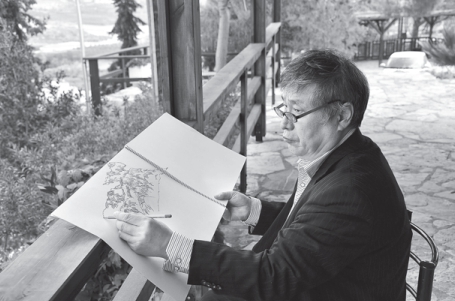 |
|
Li Geng draws a sketch while visiting a scenic spot.[Photo provided to China Daily] |
Xie points out that while the works interpret the magnificence of Mahler's music, they're full of classical Chinese poetry.
"The melodies and rhythms of music are expressed in the hues and strokes of painting," Xie says.
He praises Li Geng's exploration of the ultimate connection between music and painting, and how they nourish the human spirit in the contemporary world.
Tang, however, didn't turn to artistic creation until he retired in 2017. The 65-year-old's artworks have been shown at home and abroad, including at such important international exhibitions as the 58th Venice Biennale.
"His philosophical ideas and poetic emotions that'd accumulated and were suppressed for more than 40 years burst from his paintbrush," Li Geng says about Tang.
"He created with great passion and power."
He believes Tang is a genius, whose abstract paintings contain music and poetry. These large works are created with saturated colors on collaged rice paper. Some are more than 8 meters long and 2 meters high.
"I don't believe abstract art belongs solely to Western artists," Tang says.
In China, abstract art grew from calligraphy and traditional free-stroke ink painting, he says.
"It is rooted in Chinese culture and deeply connected to such Chinese philosophies as Confucianism, Taoism and Buddhism."
Tang calls for establishing a contemporary abstract methodology and philosophy of the East.
The abstract art of the East features the flow of qi, or life force, with lots of empty spaces in the compositions that present the essence of Eastern philosophy, he says.